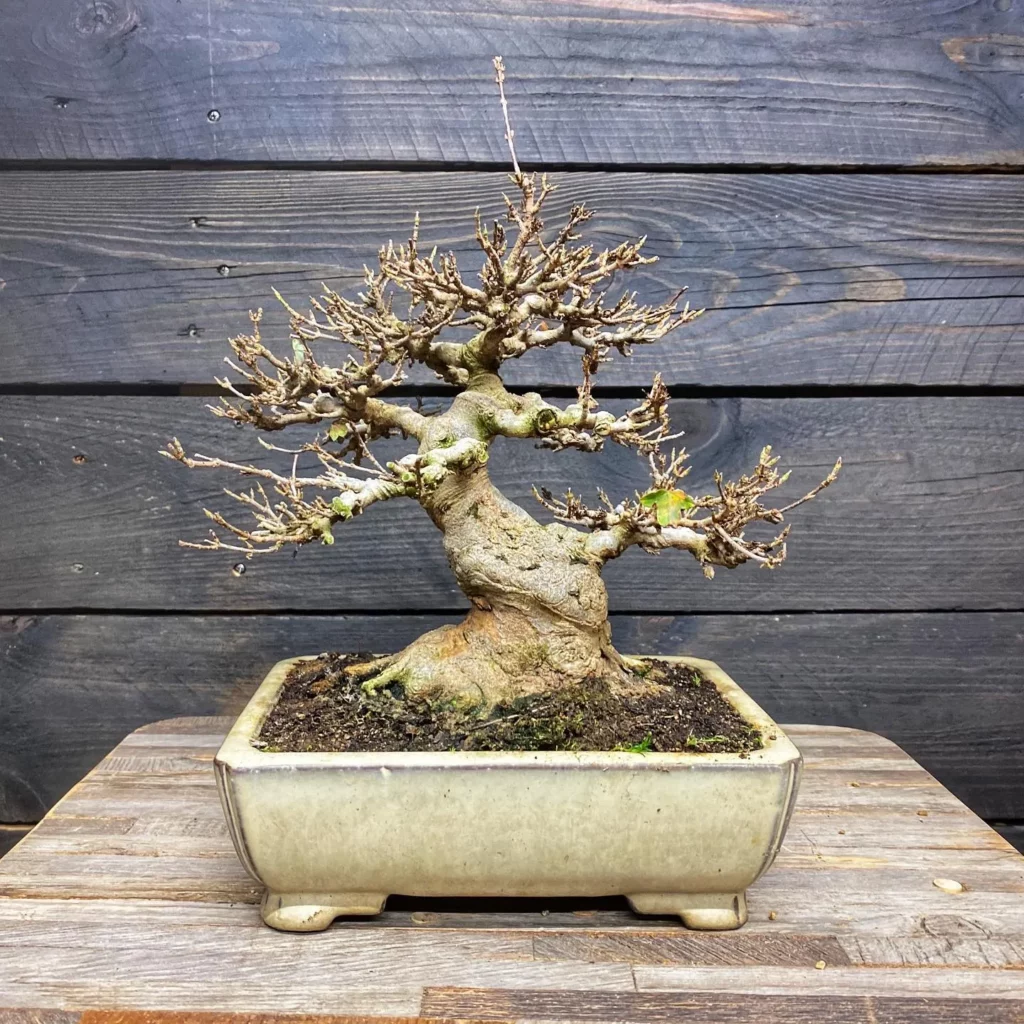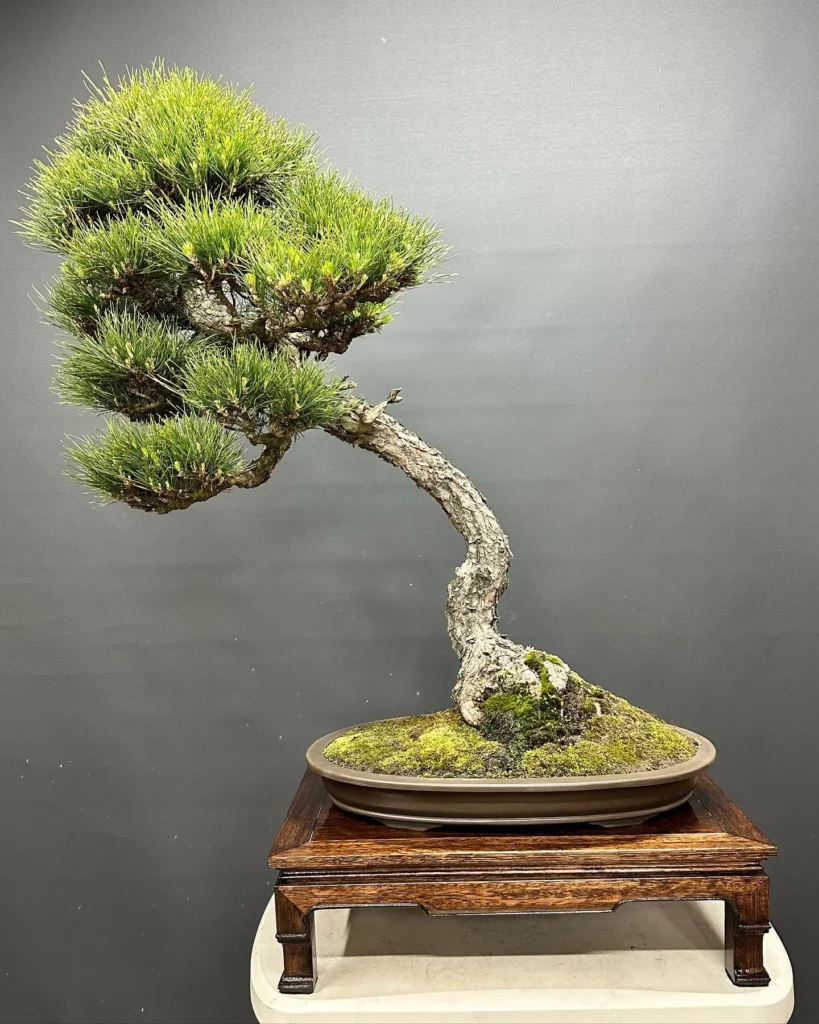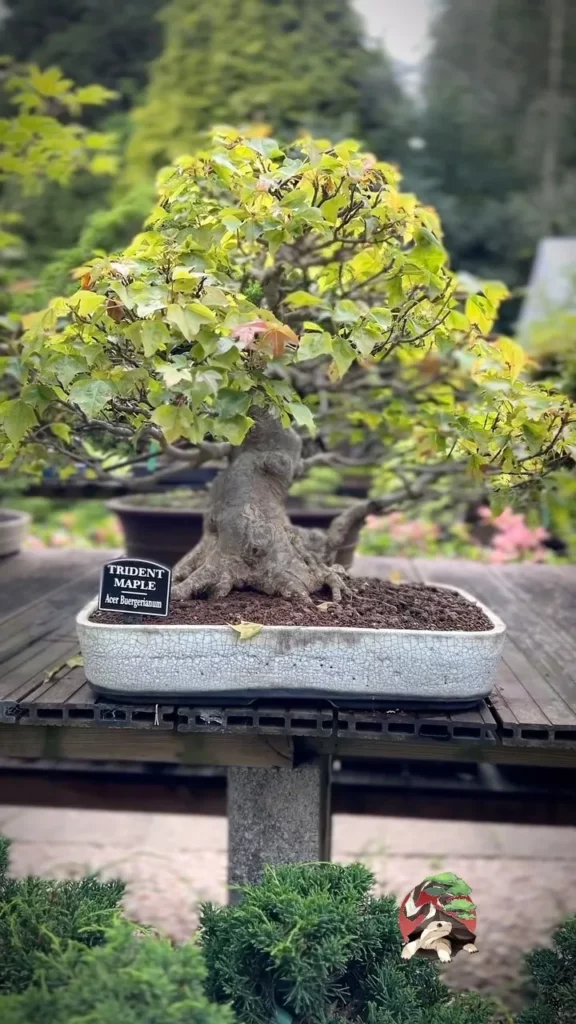The Trident Maple Bonsai, also known as Acer buergerianum, is a stunning tree that captivates with its unique appearance. Its small and delicate stature, combined with its round branches, creates an elegant and balanced silhouette. The three-lobed dark green foliage adds to its charm, providing a vibrant and lush backdrop for its seasonal transformation.
Key Takeaways:
- Trident Maple Bonsai, also known as Acer buergerianum, is a versatile and sought-after bonsai tree.
- It is a rapid-growing tree known for its beautiful foliage and adaptable nature.
- The Trident Maple Bonsai can be grown in its natural multi-stemmed habit or trained to have a single trunk.
- Proper lighting, watering, fertilizing, and potting are essential for maintaining the health of your Trident Maple Bonsai.
Appearance of Trident Maple Bonsai



In the fall, the Trident Maple Bonsai adorns itself with a breathtaking display of colors. The leaves transition from their summer green to a kaleidoscope of yellow, red, and orange hues, creating a spectacle of nature’s beauty. This fiery transformation captures the essence of autumn and adds a dramatic touch to the bonsai’s overall aesthetic.
As the Trident Maple Bonsai ages, it develops exfoliating bark that adds another layer of visual interest. The bark peels away, revealing shades of gray, brown, orange, and even hints of red. This textured bark enhances the bonsai’s natural character, showcasing the tree’s journey and evoking a sense of depth and maturity.
Key Features:
- Small and delicate stature
- Round branches
- Three-lobed dark green foliage
- Seasonal color change to yellow, red, and orange
- Exfoliating bark in shades of gray, brown, orange, and red
No products found.
Light Requirements for Trident Maple Bonsai



Proper lighting is essential for the health and growth of your Trident Maple Bonsai. This section will provide you with the necessary information to ensure your bonsai receives the right amount of light to thrive.
1. Full Sun Exposure:
Trident Maple Bonsai thrives in full sun. It should be placed in a sunny, airy location outdoors where it is protected from scorching summer sun rays. While it can tolerate some shade, it prefers at least six hours of sunlight daily. In hotter months, provide some protection from midday sun if the bonsai is in a pot.
2. Avoid Excessive Shade:
Trident Maple Bonsai requires sufficient sunlight to maintain its health and vigor. Avoid placing it in areas with excessive shade as this can lead to weak growth and sparse foliage. Providing ample sunlight will promote strong development and vibrant leaf colors.
3. Consider Seasonal Changes:
Keep in mind that lighting requirements for Trident Maple Bonsai may vary depending on the season. During spring and fall, when the tree is actively growing and changing leaf colors, it benefits from direct sunlight. In the summer, when temperatures are high, some shade during the hottest part of the day can prevent leaf scorching.
Watering Trident Maple Bonsai



Proper watering is essential for the health and vitality of your Trident Maple Bonsai. Here are some important tips to keep in mind:
- Consistency: A consistent watering schedule is crucial for your bonsai tree. During the growing season, especially on hot summer days, it is recommended to water the tree daily. However, Trident Maple Bonsai is more drought-tolerant compared to other maple species, so be mindful not to overwater.
- Observation: Pay close attention to the moisture level of the soil. Before watering, check if the top inch of soil is dry. If it feels moist, hold off on watering. Overwatering can lead to root rot and other issues.
- Technique: When watering your Trident Maple Bonsai, make sure to give it a thorough soak. Water until you see drainage at the bottom of the pot. This ensures that the entire root system receives adequate hydration.
- Seasonal Considerations: Adjust your watering routine according to the season. During winter, when the tree is dormant, reduce watering frequency to prevent waterlogged soil. In spring and summer, when the tree is actively growing, increase watering to accommodate its higher water requirements.
Signs of Overwatering or Underwatering
It’s important to be able to identify signs of overwatering or underwatering in your Trident Maple Bonsai. Here are some indicators to watch out for:
- Overwatering: Yellowing or wilting leaves, mushy or rotting roots, foul odor emanating from the soil, or standing water in the drainage tray are signs of overwatering. If you notice any of these symptoms, adjust your watering routine accordingly and improve drainage.
- Underwatering: Drooping or crispy leaves, dry and brittle soil, and a lack of new growth can indicate that your bonsai tree is not receiving enough water. Increase watering frequency and ensure the soil is thoroughly moistened during each watering session.
Fertilizing Trident Maple Bonsai



Proper fertilization is essential for the healthy growth and development of your Trident Maple Bonsai. By providing the right nutrients, you can ensure that your bonsai tree thrives and maintains its vibrant foliage.
Here are some important tips and guidelines for fertilizing your Trident Maple Bonsai:
1. Choose the right fertilizer:
When fertilizing your Trident Maple Bonsai, it’s important to use a well-balanced fertilizer specifically designed for bonsai trees. Look for a slow-release organic fertilizer that contains a good balance of nitrogen, phosphorus, and potassium (N-P-K).
2. Follow a regular fertilizing schedule:
Fertilize your Trident Maple Bonsai regularly during the growing season, typically from early spring to late summer. Apply the fertilizer according to the instructions on the package, taking care not to over-fertilize, as this can harm the tree.
3. Use liquid fertilizer for quick absorption:
In addition to using a slow-release granular fertilizer, you can also supplement with a liquid fertilizer to provide a quick nutrient boost. Liquid fertilizers are absorbed more rapidly by the bonsai tree’s roots, ensuring that it receives the necessary nutrients in a timely manner.
Potting Trident Maple Bonsai



Proper potting is essential for the health and development of your Trident Maple Bonsai. Here are some key tips to keep in mind:
- Repot your bonsai every two to three years in early spring. This allows for the pruning of the root system, promoting better growth and overall health.
- Use a well-draining bonsai soil mix that contains a combination of Akadama, Pumice, and Lava. This will ensure proper water drainage and prevent waterlogged roots.
- Carefully remove the bonsai from its current pot, gently untangling and trimming any circling or tangled roots. This will encourage new root growth and prevent root-bound issues.
- Place a layer of bonsai soil at the bottom of the new pot, positioning the bonsai in the center. Add more soil around the roots, gently pressing down to secure the tree in place.
- Water the newly potted bonsai thoroughly, allowing the water to soak through the soil and hydrate the roots. Avoid overwatering, as excessive moisture can lead to root rot.
- After potting, place the bonsai in a shaded location for a few weeks to allow it to recover from the stress of repotting. Gradually introduce it to more sunlight as it regains strength.
Propagation of Trident Maple Bonsai



If you’re looking to expand your collection of Trident Maple Bonsai trees or want to share this beautiful species with a fellow enthusiast, propagation is the way to go. Fortunately, Trident Maple Bonsai can be propagated through various methods, including seeds, cuttings, and air layering. Let’s explore each method and discover how to successfully propagate Trident Maple Bonsai.
Seeds
Propagating Trident Maple Bonsai from seeds is a rewarding process that allows you to witness the tree’s growth from its earliest stages. To get started, collect viable seeds in the fall and soak them in warm water for 24 hours. Afterward, plant the seeds in a well-draining bonsai soil mix and keep them in a warm and bright location. With patience and proper care, the seeds will germinate, and you’ll have new Trident Maple Bonsai saplings to nurture.
Cuttings
If you prefer a quicker propagation method, cuttings are the way to go. Gather healthy cuttings from your Trident Maple Bonsai in early spring, ensuring they have at least three nodes. Remove the lower leaves and dip the cut end in rooting hormone to promote root development. Plant the cuttings in a well-draining soil mix and place them in a warm and humid environment. Mist the cuttings regularly and provide them with bright but indirect light. With proper care, the cuttings will root and grow into new Trident Maple Bonsai trees.
Air Layering
Air layering is a method that allows you to create new roots on a branch or trunk while it’s still attached to the parent tree. This technique is particularly useful for propagating Trident Maple Bonsai with thicker trunks or mature branches. Select a section of the tree where you want the new roots to form, make a vertical cut and remove a strip of bark. Apply a rooting hormone to the exposed area, wrap it in moist sphagnum moss, and cover it with plastic film. Over time, the branch or trunk will develop new roots, which can then be separated and potted to create new Trident Maple Bonsai trees.
Growth and Development of Trident Maple Bonsai



Proper growth and development are essential for maintaining the health and beauty of your Trident Maple Bonsai. By following these tips, you can ensure that your bonsai tree thrives and flourishes.
1. Encourage new shoots:
Allow new shoots to grow until they have several leaf pairs. This promotes the tree’s growth and vitality. Once the shoots have developed, prune them back to just one pair of leaves. This helps maintain the bonsai’s desired shape and prevents overcrowding.
2. Prune strategically:
Pruning is a crucial aspect of bonsai care. In spring, prune your Trident Maple Bonsai when it is growing vigorously before budding. Remove any large branches or trunks in summer when the wounds heal quickly. To balance the tree’s growth, focus on pruning the top more as it tends to have stronger branches. While midsummer leaf pruning can be done to reduce leaf size, avoid pruning the leaves every year.
3. Maintain balance:
To ensure the overall aesthetic appeal of your Trident Maple Bonsai, it’s important to maintain the balance of the tree. Regularly assess the growth of branches and adjust them accordingly. By focusing on balancing the growth, you can achieve a harmonious and visually pleasing bonsai tree.
Pests and Diseases of Trident Maple Bonsai


Keeping your Trident Maple Bonsai healthy requires vigilance against potential pests and diseases. Here are some common issues to watch out for:
Pests
- Aphids: These small, soft-bodied insects can suck the sap from your bonsai tree, causing distorted growth and honeydew buildup. Control aphids by using insecticidal soap or a strong jet of water to wash them off.
- Scale Insects: These tiny, immobile insects attach themselves to the branches and leaves, sucking out plant sap. Use a soft brush or cotton swab dipped in rubbing alcohol to remove them manually.
- Spider Mites: These tiny pests can cause yellowing leaves and webbing on your bonsai. Keep humidity levels up and use a miticide to control their population.
Diseases
- Root Rot: Overwatering can lead to root rot, a fungal disease that causes the roots to decay. To prevent root rot, ensure your bonsai is planted in well-draining soil and water it sparingly. If root rot occurs, trim away affected roots and treat with a fungicide.
- Chlorosis: Hard water can cause chlorosis, a condition where the leaves turn yellow due to iron deficiency. Use rainwater or distilled water for watering to avoid this issue.
About Trident Maple Bonsai
Trident Maple Bonsai, also known as Acer buergerianum, is a versatile and sought-after bonsai tree. With its rapid growth, this deciduous tree is known for its stunning foliage and adaptable nature. Whether grown in its natural multi-stemmed habit or trained to have a single trunk, Trident Maple Bonsai is a true beauty.
What makes Trident Maple Bonsai even more captivating is its ability to change colors throughout the year. From vibrant greens in spring and summer to the fiery shades of yellow, red, and orange in the fall, this tree adds a touch of magic to any landscape.
Whether you’re a beginner or an experienced bonsai enthusiast, Trident Maple Bonsai is a great choice. Its intriguing bark texture and colors make it a captivating ornamental tree or a small bonsai specimen. So, why not bring the elegance and grace of Trident Maple Bonsai to your home or garden? It’s a rewarding experience that will surely impress.
FAQ
What is the Trident Maple Bonsai?
Trident Maple Bonsai, also known as Acer buergerianum, is a popular deciduous tree used for bonsai. It has round branches and three-lobed dark green foliage that changes colors throughout the year.
Where should I place my Trident Maple Bonsai?
Trident Maple Bonsai thrives in full sun. It should be placed in a sunny, airy location outdoors where it is protected from scorching summer sun rays. It prefers at least six hours of sunlight daily.
How often should I water my Trident Maple Bonsai?
Trident Maple Bonsai requires consistent watering. During the growing season, it should be watered daily, especially on the hottest days of summer. In winter, be careful not to overwater to prevent root rot.
What fertilizer should I use for my Trident Maple Bonsai?
Use a solid organic fertilizer, such as Maintain or Push pellets, once a month during the growing season. If your bonsai is young, choose a fertilizer high in nitrogen to promote growth. Fertilize with a liquid fertilizer weekly or every other week.
How often should I repot my Trident Maple Bonsai?
Repot your Trident Maple Bonsai every two to three years in early spring. Use a bonsai soil mix that contains Akadama, Pumice, and Lava to provide the necessary drainage.
How can I propagate Trident Maple Bonsai?
Trident Maple Bonsai can be propagated from seeds, cuttings, or air layering. Cuttings root easily in early spring. Sow seeds in the fall, after leaving them in warm water for 24 hours. Air layering involves creating new roots on a branch or trunk.
How should I prune my Trident Maple Bonsai?
Allow new shoots to grow until they have several leaf pairs, then shorten them to just one pair. Prune in spring for strong growth and prune large branches or trunks in summer. Prune the top more to balance growth. Avoid pruning leaves every year.
What are the common pests and diseases of Trident Maple Bonsai?
Common pests include aphids, scale insects, and spider mites. Regularly monitor your bonsai for signs of infestation and treat accordingly to prevent damage. Overwatering can lead to root rot, and chlorosis may occur with frequent watering using hard water.
What makes Trident Maple Bonsai unique?
Trident Maple Bonsai is known for its versatile nature and beautiful foliage. It can be grown in its natural multi-stemmed habit or trained to have a single trunk. Its exfoliating bark adds to its visual appeal.
How can I best care for my Trident Maple Bonsai?
Follow the practical tips provided in this care guide, including proper placement, watering, fertilizing, repotting, pruning, and pest control. Regularly monitor the health of your bonsai and provide the necessary care to ensure its optimal growth and development.




